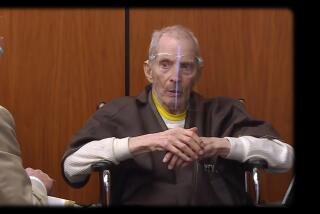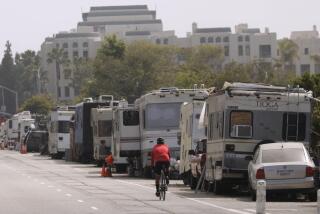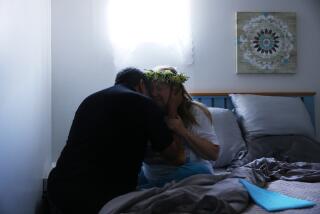PROFILE : Hearty Lady : Two years ago, Carol Furst was approaching death. Now it’s hard to keep up with her.
- Share via
Keeping up with Carol Furst is not easy. Whether she’s basking on the Mexican beaches of Cabo San Lucas, drifting in her inflatable boat in Ventura Harbor or zipping around town in her red convertible Volkswagen Bug, Furst’s zest for life never seems to ebb.
Great-grandmother of a toddler, she volunteers at a local hospital and gives her free time to the annual Special Olympics golf tournament. She and her husband, Ralph, blanket their Ventura mobile-home park with balloon bouquets to mark every birthday and anniversary of their neighbors.
Just what makes this 68-year-old woman tick?
The heart of a 24-year-old man.
Close to death, Furst received a heart transplant in 1989 and has been trying to make up for lost time ever since.
“What keeps me going is there are so many things that I was unable to do before. And now I just have to hurry, hurry, hurry to make up for a lot of years of not being able to do,” she said. “I seem to be hyperactive most of the time, and then I get to a point where I wear out and I have to go to bed for a day.”
When asked how long she expects to live, she replied with a big smile: “Forever. I’m never going to die.”
Eight years ago, a cross-country trip was cut short in Denver when she suffered two heart attacks and six cardiac arrests within two days. Thirty days later, she returned to California and the following year had double bypass surgery.
But her relief was temporary. She started noticing a gradually increasing pain in her liver that UCLA physicians discovered was the result of insufficient oxygen to her organs, resulting from her deteriorating heart that was pumping at only 10% of its usual capacity. It was decided that her only chance for survival would be a heart transplant.
At the time of her surgery, Furst was the oldest patient in the United States to undergo a heart transplant, according to Dr. Jon Kobashigawa, who heads UCLA’s heart transplant cardiologist team. Despite her age, doctors considered her a good candidate for the operation because her other vital organs were in good shape.
“It was like I was waiting for someone to die so I could live,” she said. “Afterward, I felt guilty because someone had died so I could live. But then I realized that the person was going to die anyway and wasn’t it wonderful that he had cared enough about another human being to make it possible for someone to live.”
At 4:30 a.m. on April 29, 1989, Ralph Furst was awakened by a telephone call from UCLA. A suitable replacement heart for his wife had been found. Surgery was just a few hours away. He arrived at the hospital in time to bid his wife a quick farewell as she was wheeled into surgery.
She emerged 6 1/2 hours later and beating inside her chest was the heart of a man who was killed in a vehicle accident near Riverside.
“For 15 days before the surgery, I knew I was losing her,” said Ralph Furst, a 67-year-old retired movie-set carpenter. “She wouldn’t have made it through the night.”
Furst’s doctor agreed.
“She was what we call Status 1. She was dependent on intravenous drugs and a pacemaker had been installed,” Kobashigawa said. “She was close to dying.”
Furst, a retired accountant, has been kept busy lately reassuring future transplant patients and answering questions about her operation.
“Usually, people will say to me, ‘You were so brave! How courageous you were!’ But I wasn’t. I had no choice. The Lord just meant for me to be here longer for some reason, to help others, I suppose,” she said.
But for all the attention she has received, Furst would prefer sharing the spotlight with the families of donors. Since donor records are kept confidential, Furst does not know the name of the young man whose heart allowed her a second chance at life. An anonymous letter to the man’s family, written by her husband and passed along by Furst’s doctors, never received a reply.
The difficult decision of donating a loved one’s organs, coupled with laws protecting patient confidentiality, prompts donor banks to keep the names of recipients and donors to themselves.
Still, Furst believes that the families of donors should know the result of their generosity.
“I just feel they need to know. If they don’t want to contact me, I would understand that, but there must be families who would be interested in knowing how a heart recipient is doing,” said Furst, who along with her husband willed her body to UCLA 25 years ago. “My life is exciting because of this and because I’m so thankful.”
Except for a touch of rejection in the beginning, Furst’s heart seems to have adjusted to its new surroundings. Doctors keep it in check with anti-rejection drugs and a quarterly checkup.
“I would do it again if I had to,” she said. “It makes you strong and makes you appreciate every little thing.”
UP CLOSE CAROL FURST
Her message to potential donors and donor families: “We owe our lives to them. I thank that young man every day for having that little donor sticker on his (driver’s license). If it wouldn’t have been for that, I would not be here today and I realize that.”
Sense of humor: “One day I was watching the Lakers game in the hospital and I went into cardiac arrest. They started doing CPR and came in with their zappers. When I came to, the first thing I said was, ‘What’s the score?’ ”
Favorite T-shirt phrase: “Don’t take your organs to heaven. . . . Heaven knows we need them here.”
Favorite place on Earth: Cabo San Lucas, Mexico.
Personalized license plate: 2nd Heart
More to Read
Sign up for Essential California
The most important California stories and recommendations in your inbox every morning.
You may occasionally receive promotional content from the Los Angeles Times.













